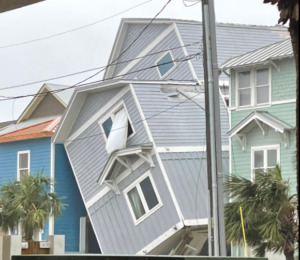 State geologists are well on their way to creating a statewide map showing where sinkholes are most likely to form.
State geologists are well on their way to creating a statewide map showing where sinkholes are most likely to form.
Last year, Florida got more than $1 million in federal funding for a three-year study. A pilot in Columbia, Hamilton and Suwannee counties ended in May. Professionals with the Florida Geological Survey visited about 230 locations, sampling and studying the land. Their fieldwork contributed to a “relative vulnerability” map that so far has proved 93 percent successful in the pilot area in predicting that sinkholes will form, geologist Clint Kromhout said. That figure was reverse-engineered by comparing the pilot’s sinkhole predictions to where “subsidence events” actually did occur. The predictions were at a countywide scale; science can’t predict where and when an individual sinkhole will occur.
The Florida Geological Survey and Florida Department of Emergency Management are collaborating on the study. Alan Baker, another state geologist, said the map will put another tool in the toolbox of emergency planners, especially after a big storm, when sinkholes often develop. “They’re prepared for floods. They’re prepared for downed power lines,” Baker said. But the sinkhole vulnerability map will provide even more preparation, this time for ground collapse.
The study next moves to the statewide phase. Kromhout and Baker plan to hire additional geologists and reach out to local governments, they said. “The ultimate desire is to have a statewide map to reduce the risk of loss of life and property,” Kromhout said. The goal for the scale of the state map is at least the county level, but Kromhout said he hopes they will be able to get to a neighborhood-by-neighborhood detail.
Tropical Storm Debby was the inspiration for the study. Heavy rains from the 2012 storm caused dozens of sinkholes, especially in Hernando County.
Sinkholes are a particular threat for many Tampa Bay residents. Hillsborough, Pasco and Hernando counties are known as “Sinkhole Alley.” For example, of all sinkhole damage reported in the state from 2006 through 2010, two-thirds came from Hernando, Hillsborough and Pasco counties, according to the Florida Office of Insurance Regulation.
Not every hole in the ground is a “sinkhole,” however. St. Petersburg police said a hole in a roadway late last month was caused by a problem with a stormwater line. In May, Winter Haven police and geologists were investigating a possible 30-foot-wide, 5-foot-deep sinkhole in the parking lot of a Publix shopping center. Other voids fit the description.
Sinkholes are common in Florida because of porous rock underground such as limestone that holds water. Over time, acid in the water dissolves the rock, creating a void. When the earth above the limestone gets too heavy, it can cave in, forming a sinkhole.
In April, a sinkhole between two residences at The Villages was filled in, then appeared to start opening again. In November, a sinkhole swallowed parts of two Dunedin houses and forced several other homes to be evacuated. In August, part of a three-story villa at Summer Bay Resort in Clermont, west of Orlando, was swallowed by a 100-foot sinkhole. No one was reported hurt. And in February 2013, a Seffner man died when a sinkhole opened under his bedroom as he slept. The body of 37-year-old Jeff Bush was not recovered.
The most famous sinkhole recently was not in Florida but in Kentucky. In February, a 60-foot-deep sinkhole opened under the National Corvette Museum in Bowling Green, collapsing the floor and swallowing eight of the vehicles, including one donated by a Pasco County man. The museum was closed at the time and no one was injured, but the value of the cars alone was estimated at $1 million. The museum’s board has decided to preserve part of the sinkhole as an attraction because news of the collapse boosted attendance by 60 percent.
This legislative session, a measure failed that would have created a sinkhole repair program for policyholders of Citizens Property Insurance Corp. Its purpose: Ensure that sinkhole damage is fixed properly and within a reasonable time. Citizens, a nonprofit government corporation, is the insurer of last resort for Florida homes in sinkhole-prone areas.
Lawmakers were concerned over homeowners getting a payout for a sinkhole but not using the money to repair the damage. Sinkhole claims also have stoked a number of lawsuits against the insurer by customers upset over bad repairs or ones that took too long.
Under the bill, sinkhole fixes would have had to be done by a contractor picked from a pool of bonded and insured repair companies approved by Citizens. A version passed the House but died in the Senate, where some lawmakers worried such a program wouldn’t be effective.
Source: TBO




